
General, Organic, and Biological Chemistry: Structures of Life (5th Edition)
5th Edition
ISBN: 9780321967466
Author: Karen C. Timberlake
Publisher: PEARSON
expand_more
expand_more
format_list_bulleted
Question
Chapter 14, Problem 14.52AQAP
Interpretation Introduction
a)
To determine:
To find the IUPAC name of the compound:

Interpretation Introduction
b)
To determine:
To find the IUPAC name of the compound:

Interpretation Introduction
c)
To determine:
To find the IUPAC name of the compound:

Interpretation Introduction
d)
To determine:
To find the IUPAC name of the compound:

Interpretation Introduction
e)
To determine:
To find the IUPAC name of the compound:

Expert Solution & Answer
Want to see the full answer?
Check out a sample textbook solution
Students have asked these similar questions
Part 2 (0.5 point)
0-
Draw the major organic product with the correct geometry.
10
1:
70000 х
く
1st attempt
Part 1 (0.5 point) Feedback
Please draw all four bonds at chiral centers.
P
See Periodic Table See Hint
Heating an alcohol in the presence of sulfuric or phosphoric acid will cause a dehydration to occur: the removal of the elements of water from a
molecule, forming an alkene. The reaction usually follows an E1 mechanism. The SN1 pathway is suppressed by using a strong acid whose conjugate
base is a poor nucleophile. Further, heating the reaction mixture causes a greater increase in the rate of E1 compared to the rate of S№1.
2nd attempt
0
See Periodic Table
See Hint
Draw the organic intermediate from the first step (no byproducts) and draw curved arrow(s) to show how it reacts.
TH
+11:
1st attempt
Feedback
H
H
H
C
F
F
See Periodic Table
See Hint
This molecule undergoes an E1 mechanism when stirred in methanol.
3rd attempt
CH₂OH
CH₂OH
6148
O
See Periodic Table. See Hint
Draw 3 chemical species including formal charges and lone pairs of electrons. Add the missing curved arrow notation.
H
N
O O SA 3
Br
I
Chapter 14 Solutions
General, Organic, and Biological Chemistry: Structures of Life (5th Edition)
Ch. 14.1 - Prob. 14.1QAPCh. 14.1 - Prob. 14.2QAPCh. 14.1 - Prob. 14.3QAPCh. 14.1 - Prob. 14.4QAPCh. 14.1 - Prob. 14.5QAPCh. 14.1 - Prob. 14.6QAPCh. 14.1 - Prob. 14.7QAPCh. 14.1 - Prob. 14.8QAPCh. 14.1 - Prob. 14.9QAPCh. 14.1 - Prob. 14.10QAP
Ch. 14.1 - Prob. 14.11QAPCh. 14.1 - Prob. 14.12QAPCh. 14.2 - Prob. 14.13QAPCh. 14.2 - Prob. 14.14QAPCh. 14.2 - Prob. 14.15QAPCh. 14.2 - Prob. 14.16QAPCh. 14.2 - Prob. 14.17QAPCh. 14.2 - Prob. 14.18QAPCh. 14.3 - Prob. 14.19QAPCh. 14.3 - Prob. 14.20QAPCh. 14.3 - Prob. 14.21QAPCh. 14.3 - Prob. 14.22QAPCh. 14.3 - Prob. 14.23QAPCh. 14.3 - Prob. 14.24QAPCh. 14.4 - Prob. 14.25QAPCh. 14.4 - Prob. 14.26QAPCh. 14.4 - Prob. 14.27QAPCh. 14.4 - Prob. 14.28QAPCh. 14.4 - Prob. 14.29QAPCh. 14.4 - Prob. 14.30QAPCh. 14.5 - Prob. 14.31QAPCh. 14.5 - Prob. 14.32QAPCh. 14.5 - Prob. 14.33QAPCh. 14.5 - Prob. 14.34QAPCh. 14.5 - Prob. 14.35QAPCh. 14.5 - Prob. 14.36QAPCh. 14.5 - Prob. 14.37QAPCh. 14.5 - Prob. 14.38QAPCh. 14.5 - Prob. 14.39QAPCh. 14.5 - Prob. 14.40QAPCh. 14.5 - Prob. 14.41QAPCh. 14.5 - Prob. 14.42QAPCh. 14 - Prob. 14.43UTCCh. 14 - The compound frambinone has the taste of...Ch. 14 - Prob. 14.45UTCCh. 14 - Prob. 14.46UTCCh. 14 - Prob. 14.47UTCCh. 14 - Prob. 14.48UTCCh. 14 - Prob. 14.49UTCCh. 14 - Prob. 14.50UTCCh. 14 - Prob. 14.51AQAPCh. 14 - Prob. 14.52AQAPCh. 14 - Prob. 14.53AQAPCh. 14 - Prob. 14.54AQAPCh. 14 - Prob. 14.55AQAPCh. 14 - Prob. 14.56AQAPCh. 14 - Prob. 14.57AQAPCh. 14 - Prob. 14.58AQAPCh. 14 - Prob. 14.59AQAPCh. 14 - Prob. 14.60AQAPCh. 14 - Prob. 14.61AQAPCh. 14 - Prob. 14.62AQAPCh. 14 - Prob. 14.63AQAPCh. 14 - Prob. 14.64AQAPCh. 14 - Prob. 14.65AQAPCh. 14 - Prob. 14.66AQAPCh. 14 - Prob. 14.67AQAPCh. 14 - Prob. 14.68AQAPCh. 14 - Prob. 14.69AQAPCh. 14 - Prob. 14.70AQAPCh. 14 - Prob. 14.71CQCh. 14 - Prob. 14.72CQCh. 14 - Prob. 14.73CQCh. 14 - Prob. 14.74CQCh. 14 - Prob. 14.75CQCh. 14 - Prob. 14.76CQCh. 14 - Prob. 14.77CQCh. 14 - Prob. 14.78CQCh. 14 - A compound called butylated hydroxytoluene, or...Ch. 14 - Prob. 28CICh. 14 - Prob. 29CICh. 14 - Prob. 30CICh. 14 - Prob. 31CICh. 14 - Cl.32 lonone is a compound that gives sweet...Ch. 14 - Prob. 33CICh. 14 - Prob. 34CI
Knowledge Booster
Learn more about
Need a deep-dive on the concept behind this application? Look no further. Learn more about this topic, chemistry and related others by exploring similar questions and additional content below.Similar questions
- Complete the mechanism for the E1 reaction below by following the directions written above each of the five boxes. Be sure to include lone pair electrons and nonzero formal charges. 1st attempt Y 0 + Provide the missing curved arrow notation. 01: See Periodic Table See Hint H C Br Iarrow_forwardPlease help answer number 2. Thanks in advance.arrow_forwardHow do I explain this? Thank you!arrow_forward
- When an unknown amine reacts with an unknown acid chloride, an amide with a molecular mass of 163 g/mol (M* = 163 m/z) is formed. In the infrared spectrum, important absorptions appear at 1661, 750 and 690 cm. The 13C NMR and DEPT spectra are provided. Draw the structure of the product as the resonance contributor lacking any formal charges. 13C NMR DEPT 90 200 160 120 80 40 0 200 160 120 80 40 0 DEPT 135 T 200 160 120 80 40 0 Draw the unknown amide. Select Dow Templates More Fragearrow_forwardIdentify the unknown compound from its IR and proton NMR spectra. C4H6O: 'H NMR: 82.43 (1H, t, J = 2 Hz); 8 3.41 (3H, s); 8 4.10 (2H, d, J = 2 Hz) IR: 2125, 3300 cm¹ The C4H6O compound liberates a gas when treated with C2H5 MgBr. Draw the unknown compound. Select Draw с H Templates Morearrow_forwardPlease help with number 6 I got a negative number could that be right?arrow_forward
- 1,4-Dimethyl-1,3-cyclohexadiene can undergo 1,2- or 1,4-addition with hydrogen halides. (a) 1,2-Addition i. Draw the carbocation intermediate(s) formed during the 1,2-addition of hydrobromic acid to 1,4-dimethyl-1,3-cyclohexadiene. ii. What is the major 1,2-addition product formed during the reaction in (i)? (b) 1,4-Addition i. Draw the carbocation intermediate(s) formed during the 1,4-addition of hydrobromic acid to 1,4-dimethyl-1,3-cyclohexadiene. ii. What is the major 1,4-addition product formed from the reaction in (i)? (c) What is the kinetic product from the reaction of one mole of hydrobromic acid with 1,4-dimethyl-1,3-cyclohexadiene? Explain your reasoning. (d) What is the thermodynamic product from the reaction of one mole of hydrobro-mic acid with 1,4-dimethyl-1,3-cyclohexadiene? Explain your reasoning. (e) What major product will result when 1,4-dimethyl-1,3-cyclohexadiene is treated with one mole of hydrobromic acid at - 78 deg * C ? Explain your reasoning.arrow_forwardGive the product of the bimolecular elimination from each of the isomeric halogenated compounds. Reaction A Reaction B. КОВ CH₂ HotBu +B+ ко HOIBU +Br+ Templates More QQQ Select Cv Templates More Cras QQQ One of these compounds undergoes elimination 50x faster than the other. Which one and why? Reaction A because the conformation needed for elimination places the phenyl groups and to each other Reaction A because the conformation needed for elimination places the phenyl groups gauche to each other. ◇ Reaction B because the conformation needed for elimination places the phenyl groups gach to each other. Reaction B because the conformation needed for elimination places the phenyl groups anti to each other.arrow_forwardFive isomeric alkenes. A through each undergo catalytic hydrogenation to give 2-methylpentane The IR spectra of these five alkenes have the key absorptions (in cm Compound Compound A –912. (§), 994 (5), 1643 (%), 3077 (1) Compound B 833 (3), 1667 (W), 3050 (weak shoulder on C-Habsorption) Compound C Compound D) –714 (5), 1665 (w), 3010 (m) 885 (3), 1650 (m), 3086 (m) 967 (5), no aharption 1600 to 1700, 3040 (m) Compound K Match each compound to the data presented. Compound A Compound B Compound C Compound D Compoundarrow_forward
- 7. The three sets of replicate results below were accumulated for the analysis of the same sample. Pool these data to obtain the most efficient estimate of the mean analyte content and the standard deviation. Lead content/ppm: Set 1 Set 2 Set 3 1. 9.76 9.87 9.85 2. 9.42 9.64 9.91 3. 9.53 9.71 9.42 9.81 9.49arrow_forwardDraw the Zaitsev product famed when 2,3-dimethylpentan-3-of undergoes an El dehydration. CH₂ E1 OH H₁PO₁ Select Draw Templates More QQQ +H₂Oarrow_forwardComplete the clean-pushing mechanism for the given ether synthesia from propanol in concentrated sulfurica140°C by adding any mining aloms, bands, charges, nonbonding electron pairs, and curved arrows. Draw hydrogen bonded to cayan, when applicable. ore 11,0 HPC Step 1: Draw curved arrows Step 2: Complete the intend carved Q2Q 56 QQQ Step 3: Complete the intermediate and add curved Step 4: Modify the structures to draw the QQQ QQQarrow_forward
arrow_back_ios
SEE MORE QUESTIONS
arrow_forward_ios
Recommended textbooks for you
 ChemistryChemistryISBN:9781305957404Author:Steven S. Zumdahl, Susan A. Zumdahl, Donald J. DeCostePublisher:Cengage Learning
ChemistryChemistryISBN:9781305957404Author:Steven S. Zumdahl, Susan A. Zumdahl, Donald J. DeCostePublisher:Cengage Learning ChemistryChemistryISBN:9781259911156Author:Raymond Chang Dr., Jason Overby ProfessorPublisher:McGraw-Hill Education
ChemistryChemistryISBN:9781259911156Author:Raymond Chang Dr., Jason Overby ProfessorPublisher:McGraw-Hill Education Principles of Instrumental AnalysisChemistryISBN:9781305577213Author:Douglas A. Skoog, F. James Holler, Stanley R. CrouchPublisher:Cengage Learning
Principles of Instrumental AnalysisChemistryISBN:9781305577213Author:Douglas A. Skoog, F. James Holler, Stanley R. CrouchPublisher:Cengage Learning Organic ChemistryChemistryISBN:9780078021558Author:Janice Gorzynski Smith Dr.Publisher:McGraw-Hill Education
Organic ChemistryChemistryISBN:9780078021558Author:Janice Gorzynski Smith Dr.Publisher:McGraw-Hill Education Chemistry: Principles and ReactionsChemistryISBN:9781305079373Author:William L. Masterton, Cecile N. HurleyPublisher:Cengage Learning
Chemistry: Principles and ReactionsChemistryISBN:9781305079373Author:William L. Masterton, Cecile N. HurleyPublisher:Cengage Learning Elementary Principles of Chemical Processes, Bind...ChemistryISBN:9781118431221Author:Richard M. Felder, Ronald W. Rousseau, Lisa G. BullardPublisher:WILEY
Elementary Principles of Chemical Processes, Bind...ChemistryISBN:9781118431221Author:Richard M. Felder, Ronald W. Rousseau, Lisa G. BullardPublisher:WILEY

Chemistry
Chemistry
ISBN:9781305957404
Author:Steven S. Zumdahl, Susan A. Zumdahl, Donald J. DeCoste
Publisher:Cengage Learning

Chemistry
Chemistry
ISBN:9781259911156
Author:Raymond Chang Dr., Jason Overby Professor
Publisher:McGraw-Hill Education

Principles of Instrumental Analysis
Chemistry
ISBN:9781305577213
Author:Douglas A. Skoog, F. James Holler, Stanley R. Crouch
Publisher:Cengage Learning

Organic Chemistry
Chemistry
ISBN:9780078021558
Author:Janice Gorzynski Smith Dr.
Publisher:McGraw-Hill Education

Chemistry: Principles and Reactions
Chemistry
ISBN:9781305079373
Author:William L. Masterton, Cecile N. Hurley
Publisher:Cengage Learning

Elementary Principles of Chemical Processes, Bind...
Chemistry
ISBN:9781118431221
Author:Richard M. Felder, Ronald W. Rousseau, Lisa G. Bullard
Publisher:WILEY
07 Physical Properties of Organic Compounds; Author: Mindset;https://www.youtube.com/watch?v=UjlSgwq4w6U;License: Standard YouTube License, CC-BY